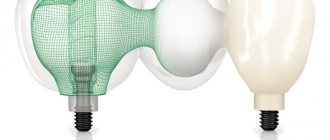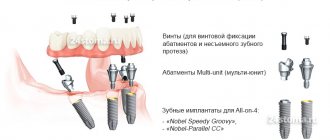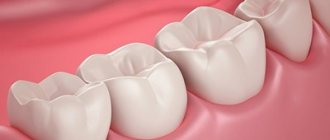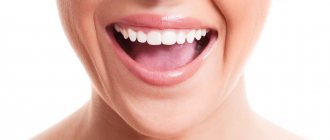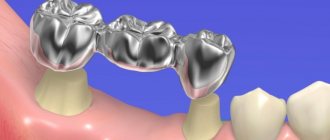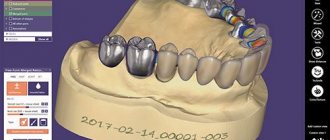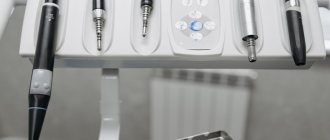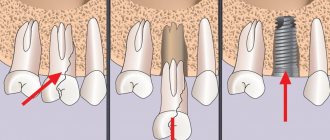How many unpleasant sensations deformed, chipped or missing teeth give a person, and all because they interfere with the ability to make a favorable impression and deprive them of confidence in further communication. To correct this and restore the former beauty of your smile, you need to seek help from a dentist. Unfortunately, it is not always easy for the patient to explain his wishes in words. And this is where wax modeling comes to the rescue!
Modeling allows you to achieve a perfect match between the dentures and the teeth. With the help of modeling, it is possible to reproduce as accurately as possible the anatomical shape and functioning features of the dentition, as well as to ensure a high degree of aesthetics of the oral cavity.
What is Wax-up technology?
Wax-up is a modern technology for modeling your smile. With its help, even before installing veneers or crowns, you can see the changes in teeth that will occur after their installation. The innovation makes it possible to eliminate possible deficiencies and imperfections and change the shape of teeth even before they are installed.
Despite many advantages, this technology also has its disadvantages:
- The prosthetic design allows you to evaluate the position and shape of the new tooth. At the same time, it is impossible to determine whether the shade of the new enamel is exactly right;
- The Wax-up model does not allow you to determine the range of possible chewing movements.
Wax up smile modeling
Wax Up modeling allows you to simulate the future result of the dentist’s work.
The patient is asked to confirm the shape and size of the teeth using a wax model, and to carry out treatment in accordance with the planned plan. Wax modeling is used exclusively to demonstrate the future result to the patient and adjustments using technical wax.
Modeling a future smile for patients PLANT.Ru
Video with a patient about the use of Mock Up and Wax Up in PLANT.Ru
When are Wax-up and Mock-up needed?
Doctors may recommend performing one of the presented technologies if the patient has bite distortions, as a result of which increased tooth wear. Also, the procedure may be required to restore one or more teeth. In cases where the patient has problems with the joints. The procedure is appropriate for:
- Restoring a completely destroyed tooth;
- Restoration of a whole range of teeth;
- For aesthetic restoration of teeth in the smile area.
General idea and how to model teeth using wax
Modeling teeth from wax is also called the Wax-up procedure, which directly refers to the material itself from which the model will be made.
In other words, Wax-up is a mandatory procedure, without which it is impossible to perform prosthetics or install implants.
Wax prosthetics is based on creating an individual impression of the oral cavity. Based on the finished impression, temporary dentures or crowns will be made.
The resulting wax model provides the basis on which an experienced dental technician will construct the permanent restoration.
To make an impression down to the smallest detail, dentists restore destroyed or damaged teeth using liquid wax.
At the moment when the wax hardens, the specialist has the opportunity to see how accurate the contact of the formed temporary prosthesis is with the antagonist tooth.
At this point, it is important to determine how correctly the chewing load is distributed in the oral cavity. The patient should be as comfortable as possible and should not have any unpleasant sensations.
Having collected all the necessary data, the doctor begins to plan treatment therapy and the subsequent stage of prosthetics.
Material requirements
Types I and II wax are often used for wax-up. The first type is appropriate to use for modeling using the direct method, and the second type for the indirect method. This is due to the fact that the second type of wax is of lower quality, which does not in any way affect the result of the impression.
Also read: Orthognathic bite: its signs and treatment methods
The first type of wax is an ideal option for modeling structures directly in the client’s oral cavity.
There are several rules for the selection, storage and use of waxes, namely:
- To achieve greater contrast, it is better to use colored waxes, such as red or blue.
- After cooling, the material should retain its rigidity, but not crumble.
- During the heating process, there should be no crumbs in the wax mass, which can affect the quality. Crumbs and flakes in the mass can create a textured surface rather than a smooth one.
- During the scraping process of the model, the material should not fall off in pieces or form chips.
- Wax should not be stored longer than the permissible period, as this may affect its quality.
In order for the model to be high-quality and accurate, it is necessary to select the correct wax depending on the modeling method.
What is Mock-up
This technology gives the patient the opportunity to appreciate the beauty of the restored smile and chewing teeth even before the prosthetic structure is made.
Advantages:
- Such structures made using Mock-up technology make it possible not only to immediately evaluate the visual effect of future prosthetics, but also to use temporary structures until permanent ones are made.
- While wearing temporary Mock-up structures, the patient can make adjustments until the permanent form is made.
- Using this technology, the doctor can make a prosthesis with an ideal fit.
Indications
Factors that determine the advisability of wax modeling of teeth include:
- Pathological abrasion of enamel, the vulnerability of which is caused by congenital anomalies, including improper development of the bite;
- Extensive damage to adjacent tissues and crown structure caused by the spread of caries;
- Deterioration of the shade of the enamel coating caused by bad habits or chronic diseases;
- Preparation for the installation of artificial pins for partial or extensive edentia;
- Diagnosis of multiple defects requiring prosthetics using bridge structures.
Wax Up helps you choose a design whose dimensions will ensure comfortable wearing. The procedure is absolutely painless and does not harm the condition of the enamel or gums. It should be taken into account that there are a number of medical limitations associated with both the composition of the material and the identification of complex pathologies that require additional treatment.
Mock-up stages
- The doctor makes a wax model of future teeth, taking into account the patient’s wishes.
- After making the wax, plaster impressions are created.
- No enamel grinding is needed for this technology.
- The plastic is placed into a silicone model and placed on the patient’s natural teeth.
- After removing the silicone, a temporary plastic structure remains in the oral cavity.
In cases where a patient comes to the doctor with complex oral problems, the installation of structures can be carried out in several stages. The patient needs some time to get used to the new forms, to evaluate how comfortable they sit, and whether they cause inconvenience when chewing food or talking. After which, the doctor evaluates the quality of the impression made, including based on the patient’s complaints. Decides whether future restoration can solve existing imperfections.
Methods
The following techniques are used for dental wax modeling:
- direct with making an impression in the Patient’s mouth;
- indirect, requiring preliminary production of a plaster product; it takes less time, but there are some features of the procedure.
Each method has its own pros and cons:
- the indirect method is more convenient for the Patient, since the time spent in the chair is reduced, in addition, the edges of the product can be processed more accurately;
- with the direct method it is better to produce single models;
- the indirect technique is recommended for hard-to-reach areas.
Virtual wax-up with the principles of sequential dental disocclusion
Tags: Digital dentistry
During the dental rehabilitation of patients, especially in cases of complete (total) reconstruction of the dentition, the issue of correct, accurate and rapid design of the anatomy and function of the teeth is acute. This is necessary both at the stage of planning dental treatment and at other stages of treatment: planning implant treatment and making surgical templates, making temporary prosthetics at various stages and making final restorations.
Traditionally, modeling of dentition and their reconstruction is carried out with wax (wax-up) on plaster models installed in an individually configured articulator (Fig. 1).
Rice. 1. Wax modeling on plaster models in an articulator
This work is not easy and requires the performer (usually dental technicians, sometimes dentists) to concentrate, thoughtfulness, mastery of the clinical situation and good manual skills. If you do only one such modeling (one clinical case), without parallel production of other dental work, then you need to spend about 2-3 working days. And if a dental technician needs to be distracted by other work at the same time, then the time to complete one “wax-up” increases to 5-6 days, sometimes 2-3 weeks!
However, often during the treatment process it is necessary to make adjustments to the previously carried out wax modeling work, and sometimes to completely redo the entire work, as significant changes occur in the clinical situation, especially after surgical bone augmentation and implantation. All this complicates an already difficult job.
It is also difficult to subsequently transfer the results of “wax-up” to other plaster models, given a changing clinical situation. It is worth mentioning the high cost for the patient of wax modeling, which in terms of labor costs is comparable to the manufacture of ceramic restorations, but cannot cost the same.
All of the above forces us to look for simpler, more accessible, accurate and reproducible methods for modeling dentition. In our opinion, today such a method is the virtual construction of dentition in special computer programs, the so-called “virtual wax-up” (Fig. 2).
Rice. 2. Virtual teeth modeling
To carry out such work, you need a confident level of computer skills and knowledge of the features of the computer program in which teeth modeling takes place. Of course, in order to move from a real modeling method to a virtual one, time and some preparation are needed, but this technique very quickly justifies itself, since it will significantly save time on carrying out a “virtual wax-up” and will provide such colossal opportunities that are difficult to imagine when carrying out conventional wax modeling on plaster models.
Let us dwell in detail on the features of virtual dental modeling and the ease of its subsequent use. To carry out such work, it is necessary to transfer the patient’s clinical situation into virtual space, i.e. either digitize existing plaster casts or perform intraoral scanning, the latter method we used to illustrate this article (Fig. 3).
Rice. 3. Intraoral scanning and obtained virtual models of dentition
Computer technologies make it possible to transfer the clinical situation into a virtual articulator configured for an individual function, and also allow for the superposition of three-dimensional photographs of the face (which is very important for taking into account aesthetic parameters) and the results of a cephalometric analysis of TRG of the head in a lateral projection (which is important for the functional construction of the dentition) (Fig. 4).
Rice. 4. Virtual clinical situation. Combined 3D photographs and cephalometric TRG data
In our clinical practice, to model the dentition, we have completely switched to “virtual wax-up”, for which we use equipment and computer software from Zirkonzahn (Italy), as well as the FaceHunter device for obtaining 3D photographs of the face (Fig. 5). Intraoral scanning was performed with a Trios camera with software from 3Shape (USA).
Rice. 5. Taking 3D photographs of the face with FaceHunter
After creating the virtual project, we proceed to constructing the dentition in a predetermined position of the lower jaw and the height of the lower third of the face. The first important guideline when constructing the occlusal plane of the lower dentition is the level of its location and the angle of inclination, taking into account the aesthetics of the frontal part of the dentition. This is helped by cephalometric landmarks, pre-calculated for the TRG of the head in the lateral projection and combined with virtual models of the dentition. Using the same cephalometric data, it is also possible to construct the required radius of the Spee curve (Fig. 6).
Rice. 6. Virtual construction of the required radius of the Spee curve
In the classical construction of dentition, we use the principle of “one tooth, two antagonists”, however, the clinical situation is not always so clear, sometimes it is necessary to apply the principle of construction “tooth to tooth” (Fig. 7).
Rice. 7. Closing teeth according to the “tooth to tooth” principle
It is only necessary to ensure that the tubercle of the simulated tooth does not fall into the tubercle of the antagonist, but into the fossa on the chewing surface. Such a compromise between the cusps of the teeth can almost always be achieved, which will not lead to increased wear (provided there is a sufficient angle of separation between the molars - the “disocclusion angle”) (Fig. 8).
Rice. 8. Static occlusal contacts
It is quite simple to make adjustments to the already completed modeling of the dentition, although often in order to change one tooth it is necessary to adjust the entire dentition and, accordingly, the antagonist teeth. Can you imagine what needs to be done in this case when performing wax modeling on plaster models, how much labor and time is required for this?!
For adequate functioning of the dentition, their harmonious sliding during lateral movements of the lower jaw with subsequent separation of the chewing teeth and dominance of the canine is very important. This can also be achieved during virtual wax modeling using the “ignore teeth” function - this simulates the extraction of stamps of individual teeth on a collapsible plaster model. In this way, the required sliding angle (based on the articular angles) can be achieved in the area of the first molar, second premolar, first premolar, as well as the canine and incisors. Such anatomy and function of the teeth will make it possible to subsequently avoid excessive overload during parafunction and bruxism, which will prevent chipping of restorations and increased wear of natural teeth (Fig. 9).
Rice. 9. Imitation of lateral sliding of the lower jaw to the left (left-sided laterotrusion)
After completing the virtual modeling of the teeth, real models of the reconstructed dentition can be produced by milling or printing and, if necessary, installed in the space of the real articulator using a special milled positioner. According to these models
the doctor can make the necessary forms (“keys”) for tooth preparation, direct temporary restorations, etc. (Fig. 10).
Rice. 10. Models of jaws made by 3D printing
If necessary, the results of the resulting virtual simulation can be easily adapted to another virtual or real model.
Creating a full-fledged virtual simulation (wax-up) of one clinical case, with good preparation and computer literacy, takes from 2 to 4 hours. In our opinion, it is very good when the attending physician takes part in such modeling, and sometimes the attending physician himself is able to carry it out completely, which contributes to the development of medical thinking, the doctor’s knowledge of the anatomy and function of the dentition. In addition, the doctor has a better command of the clinical situation and, when modeling, thinks through various options for treatment and construction of the dentition. As Professor Rudolf Slavicek said: “... when I perform a wax-up, I think about the clinical situation...”.
Source: Digital Dentistry Magazine
Similar articles:
Aki Linden
Digital smile design and CAD/CAM technologies: production of provisional reproductions and final restorations
Cancellation
Treatment planning and smile design are integral stages of comprehensive rehabilitation in aesthetic dentistry.
Aki Linden Read
Ilaria Caviggioli, Fabrizio Molinelli, Massimiliano Rossi
Computer modeling of a smile. Creating a full bridge prosthesis using the Digital Smile System application
Cancellation
New technologies in dentistry are actively attacking traditional ones in order to become one of the main tools in planning and implementing dental prosthetics.
Ilaria Caviggioli, Fabrizio Molinelli, Massimiliano Rossi Read
Sepehr Zarrine, Jerome Vaysse
Temporary CAD/CAM restorations and a digital approach to dental rehabilitation
Cancellation
Achieving a predicted successful treatment outcome through immediate loading of dental implants is still one of the most challenging tasks in modern dental practice.
Sepehr Zarrine, Jerome Vaysse Read
Julian Conejo, Markus B. Blatz
A new approach to the production of an aesthetic crown on an implant using advanced CAD/CAM technologies
Cancellation
Proper planning of iatrogenic intervention remains the first and, of course, one of the most important stages in the complex treatment of patients with dental implants in an aesthetically important area.
Julian Conejo, Markus B. Blatz Read
Petra Gierthmuhlen, Udo Plaster
Restoration of bite height through total rehabilitation using digital technologies
Cancellation
The problem of tooth wear and erosion is becoming increasingly common among dental patients.
Petra Gierthmuhlen, Udo Plaster Read
Richard Marcelat
Maxillary atrophy: rehabilitation with a customized CAD/CAM titanium bar
Cancel
Today, CAD/CAM technology plays an increasingly important role in the manufacture of implant-supported prosthetics. Digital methods provide significant advantages in terms of accuracy of superstructure fit.
Richard Marcelat Read Valerio Bini
Aesthetic digital smile design (EDS): 3D visual perception and spatial morphological indications. Part 1
Cancel
Digital smile design (DSD) is a pre-digital design method that uses digital image processing software.
Valerio Bini Read Dmitry Galkin, Yulia Kobzeva
Digital planning and restoration of a smile using the Digital Smile System program
Cancellation
The patient had been using a locking clasp denture of the upper jaw for more than 10 years. After this time, there was a strong decrease in the height of the bite...
Dmitry Galkin, Yulia Kobzeva Read Kirill Kostin
Use of various digital tools in the planning and implementation of esthetic ceramic restorations. Skyn concept. Clinical case. Part 1
Cancel
This article presents a case study of the use of the concept and various digital tools for the planning and creation of all-ceramic CAD-CAM restorations.
Kirill Kostin Read
David S. MacLean
Bioaesthetic restoration of highly abrasive teeth
Cancellation
Using the principles of Bioaesthetics to obtain a complete and accurate diagnosis, it is possible to restore the function of the pathologically altered masticatory system, achieving a predictable and long-term result.
David S. MacLean Read
Hsuan Chen
Top 10 Intraoral Scanners 2022 (CEREC Digest)
Cancel
Based on real-world first-scan data collected by the CEREC Asia team, we evaluated each scanner on four criteria: speed, size, ease of use, and scan correction performance.
Hsuan Chen Read
Kois John, Tse Tak On
Digital smile design and dentofacial analysis: how to restore aesthetics while preserving the structure of the teeth?
Cancel
Digital smile design, also known as DSD (Digital smile design), is a popular trend for planning and visualizing the results of aesthetic rehabilitation in dentistry.
Kois John, Tse Tak On Read
- ‹
- 1
- …
